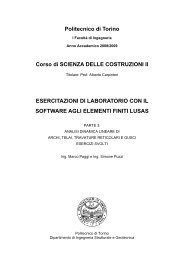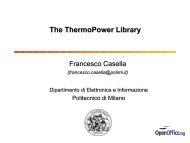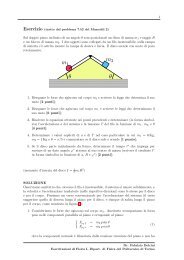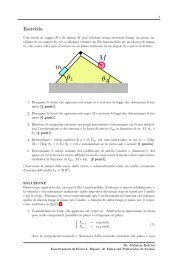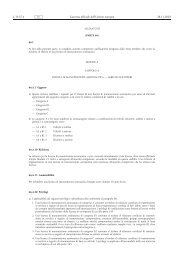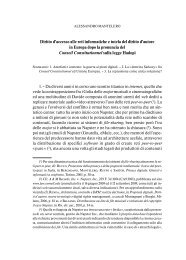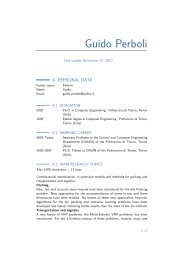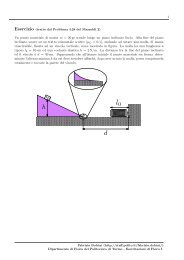The ITER toroidal field model coil project
The ITER toroidal field model coil project
The ITER toroidal field model coil project
You also want an ePaper? Increase the reach of your titles
YUMPU automatically turns print PDFs into web optimized ePapers that Google loves.
208 A. Ulbricht et al. / Fusion Engineering and Design 73 (2005) 189–327<br />
Table 4.3<br />
<strong>The</strong> test procedure for Phase 2 (TFMC + LCT <strong>coil</strong>)<br />
Position number Procedure<br />
1 Checkouts at RT<br />
2 Cool down<br />
3 Checkouts at operation temperature (∼4.5 K)<br />
4 Single <strong>coil</strong> test TFMC analog to [20], no cycling<br />
5 Single <strong>coil</strong> test LCT <strong>coil</strong> up to 11.3 kA at 4.5 K analog [20], no cycling, no current sharing measurements<br />
6 TFMC + LCT <strong>coil</strong>, low current checkouts (IT = 3.5 kA, IL = 0.8 kA, F = 0.0025 × F0 a ) at 4.5 K<br />
Ramp up–hold–ramp down (ramp rate TFMC: 22 A/s, LCT: 5 A/s)<br />
Ramp up–hold–inverter mode discharge (max. power supply voltage) (ramp rate TFMC: 79 A/s, LCT: 18 A/s)<br />
Ramp up–hold–safety discharge (exponential current decay) (ramp rate TFMC: 22 A/s, LCT: 5 A/s)<br />
7 TFMC + LCT <strong>coil</strong>, ramping up in selected currents steps in fractions of F0 at 4.5 K<br />
{IT [kA], IL [kA], F/F0 [1]}: {10, 2.3, 0.021}, {20, 4.6, 0.082}, {30, 6.9, 0.18}, {35, 8, 0.25}, {49.5, 11.3, 0.5}<br />
For each step: repeat procedure of position 6b 8 LCT single <strong>coil</strong> test up to 16 kA at 3.5 K analog to [20], no cycling, no current sharing measurements<br />
9 TFMC at 4.5 K + LCT <strong>coil</strong> at 3.5 K, ramping up in selected currents steps in fractions of F0<br />
{IT [kA], IL [kA], F/F0 [1]}: {60.6, 13.9, 0.75}, {66.4, 15.2, 0.9}, {70, 16, 1.0}<br />
For each step: repeat procedure of position 6b 10 TFMC at 4.5 K + LCT <strong>coil</strong> at 3.5 K, optimisation of the heating procedure without current<br />
11 TFMC at 4.5 K + LCT <strong>coil</strong> at 3.5 K, determination of the operation limits (TCS) by stepwise increase of the heating<br />
power of inlet helium of two pancakes at F0<br />
{IT [kA], IL [kA], F/F0 [1]}: {70, 16, 1.0} till trans. into normal conducting state occurs<br />
12 TFMC at 4.5 K + LCT <strong>coil</strong> at 3.5 K, TFMC cycling by a total of 28 triangular current pulses at four current levels<br />
with a ramp rate 140 A/s and LCT <strong>coil</strong> at 16 kA steady state operation<br />
{IT [kA], IL [kA], F/F0 [1]}: {35, 16, 0.5}, {52, 16, 0.75}, {63, 16, 0.90} c , {70, 16, 1.0} c<br />
13 Repeat Pos. 9 for {70, 16, 1.0}: ramp up–hold–ramp down, check mechanics<br />
14 Repeat Pos. 10 + 11 for {80, 14, 1.0}<br />
15 Repeat Pos. 10 + 11 for {80, 16, 1.14}<br />
16 TFMC fast high voltage discharge d : IT = 6 kA, UT = 4.8 kV, τ = 26.5 ms<br />
17 Standardised 25 kA safety discharge for measurement of electrical losses performed at suitable positions in the test<br />
procedure<br />
18 High voltage (HV) tests: DC, AC, partial discharge, pulse voltage<br />
<strong>The</strong>se tests are performed in the relevant position numbers of the test procedure, e.g., 1, 3, 15–17<br />
19 Daily tests before starting testing: DC HV test, low current safety discharge<br />
20 Final checkout at operation temperature<br />
21 Warm up<br />
22 Checkout at room temperature<br />
a Rated attractive Lorentz forces F0 ∼ IT × IL; IT = ITFMC; IL = ILCT; F0 is defined for the reference load case TFMC 70 kA/LCT 16 kA.<br />
b <strong>The</strong> inverter mode discharge was omitted for IT > 35 kA because the faster achieved IT ∼ 0 led to undefined power supply operation, which<br />
caused excessive electric losses in the TFMC. <strong>The</strong> reason is the magnetic coupling between TFMC and LCT <strong>coil</strong>, which has for same inverter<br />
voltage a smaller ramp rate caused by much higher inductance (LLCT = 1.57 H, LTFMC = 0.027 H).<br />
c During cycling at these current levels two quenches of the LCT <strong>coil</strong> occurred. <strong>The</strong> reason was a too low temperature margin. After lowering<br />
the inlet temperature to 3.0 K no more quenches occurred.<br />
d <strong>The</strong> LCT <strong>coil</strong> is shorted by its safety discharge resistor.<br />
the operation of the LCT <strong>coil</strong> winding in the temperature<br />
range between 3 and 3.5 K. This was necessary<br />
to operate the NbTi <strong>coil</strong> up to a current of 16 kA. For<br />
the cool down, the He was supplied directly from the<br />
2 kW refrigerator to the test configuration in a separate<br />
transfer line, whereas during operation at the temperature<br />
level of 4.5 K, the 2 kW refrigerator liquefied He<br />
into the control dewar (B250), while both <strong>coil</strong>s and



